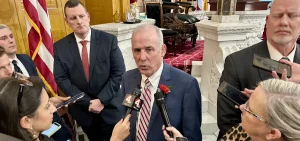News
Ohio’s new House Speaker says the current formula for funding public K-12 schools might be “unsustainable”
By: Jo Ingles | Statehouse News Bureau
Posted on:
COLUMBUS, Ohio (Statehouse News Bureau) — The new speaker of the Ohio House said the current bipartisan method of funding the state’s public K-12 schools that has been used in the past two budgets is “unsustainable.” Speaker Matt Huffman (R-Lima) made his comments a few weeks before the two-year budget process gets started in early February.

“You can’t bind four years later what a General Assembly could do. That’s because you don’t know how much money you’re going to have and all of that. So having said that, I don’t think there is a third phase to Cupp-Patterson,” Huffman said. “I think those increases in funding are unsustainable.”
And Huffman said he wants to take a close look at how the dollars already allocated to public K-12 schools are being used.
“We have to look at whether these dollars are being spent wisely in some districts,” Huffman said.
One of Ohio’s two teachers’ unions responds
The president of the 20,000-member Ohio Federation of Teachers said she’s disappointed to hear about Huffman’s willingness to go away from the plan. Melissa Cropper said it’s helped school districts by tailoring funding to meet the specific needs of their students.
“Our schools need that reliability of those funds coming in, they need that certainty of what kind of funds are coming in,” Cropper said. “Looking at the personnel within the school, looking at the number of disadvantaged pupils that are in the school, the economic backgrounds of students in school, and what kind of needs that might produce, all those different factors have an impact.”
Cropper said public school districts are doing the best they can under difficult circumstances.
“I find it hard to believe that we have school districts that have money that they’re sitting on that they don’t need,” Cropper said.
Cropper said most public schools are operating on tight budgets, which are made worse by expansion of the EdChoice voucher program, which she said allow dollars that would have gone to those schools are being directed to private schools instead. Huffman is a strong supporter of vouchers, which added up to around $1 billion in the last year.

